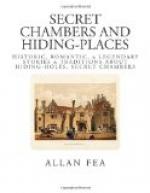Even the notorious Judge Jeffreys had in his house facilities for concealment and escape. His old residence in Delahay Street, Westminster, demolished a few years ago, had its secret panel in the wainscoting, but in what way the cruel Lord Chancellor made use of it does not transpire; possibly it may have been utilised at the time of James II.’s flight from Whitehall.
A remarkable discovery was made early in the last century at the Elizabethan manor house of Bourton-on-the-Water, Gloucestershire, only a portion of which remains incorporated in a modern structure. Upon removing some of the wallpaper of a passage on the second floor, the entrance to a room hitherto unknown was laid bare. It was a small apartment about eight feet square, and presented the appearance as if some occupant had just quitted it. A chair and a table within, each bore evidence of the last inmate. Over the back of the former hung a priest’s black cassock, carelessly flung there a century or more ago, while on the table stood an antique tea-pot, cup, and silver spoon, the very tea leaves crumbled to dust with age. On the same storey were two rooms known as “the chapel” and the “priest’s room,” the names of which signify the former use of the concealed apartment.
Sir Walter Scott records a curious “find,” similar in many respects to that at Bourton. In the course of some structural alterations to an ancient house near Edinburgh three unknown rooms were brought to light, bearing testimony of their last inmate. One of them had been occupied as a bedroom. The clothing of the bed was disarranged, as if it had been slept in only a few hours previously, and close by was an antique dressing-gown. How interesting it would be to know some particulars of the sudden surprise which evidently drove the owner of the garment from his snug quarters—whether he effected his escape, or whether he was captured! The walls of this buried chamber, if they could speak, had some curious story to relate.
Not many years ago the late squire of East Hendred House, Berkshire, discovered the existence of a secret chamber in casually glancing over some ancient papers belonging to the house. “The little room,” as it was called, from its proximity to the chapel, had no doubt been turned to good account during the penal laws of Elizabeth’s reign, as the chamber itself and other parts of the house date from a much earlier period.
Long after the palatial Sussex mansion of Cowdray was burnt down, the habitable remains (the keeper’s lodge, in the centre of the park) contained an ingenious hiding-place behind a fireplace in a bedroom, which was reached by a movable panel in a cupboard, communicating with the roof by a slender flight of steps. It was very high, reaching up two storeys, but extremely narrow, so much so that directly opposite a stone bench which stood in a recess for a seat, the wall was hollowed out to admit of the knees. When this secret chamber was discovered, it contained an




